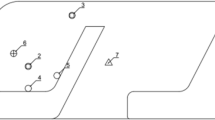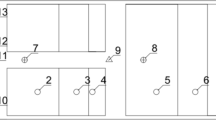Abstract
Determining the thermal conditions in an automobile and their effects on the driver is an important issue from both thermal comfort and driving safety points of view. Especially in hot summer season, the interior thermal conditions in automobile change rapidly when the air conditioning unit runs. In this study, standard air conditioning system is switched in an automobile parked in the sun and then the interior thermal conditions of the automobile are determined in detail during the 1-h cooling period. During the period, relative humidity, air velocity, air and surface temperature measurements are taken at numerous locations in the automobile. Moreover, in order to evaluate the effects of transient interior thermal conditions on the occupant, the skin temperatures of human body are measured at nine points. In addition to this, the thermal sensation of the human subject is also questioned during the cooling period. Subjective thermal comfort data is recorded using a questionnaire. The series of tests are conducted on two different automobiles, and the experimental results for both automobiles are presented and scrutinized.





















Similar content being viewed by others
References
ASHRAE (1989) ASHRAE handbook—fundamentals, chap 8. American Society of Heating, Refrigeration and Air-Conditioning Engineers, Atlanta
Chakroun C, Al-Fahed S (1997) Thermal comfort analysis inside a car. Int J Energy Res 21:327–340
Burch SD, Pearson JT, Ramadhyani S (1991) Experimental study of passenger thermal comfort in an automobile under severe winter conditioning. ASHRAE Trans 97:239–246
Burch SD, Ramadhyani S, Pearson JT (1991) Analysis of passenger thermal comfort in an automobile under severe winter conditioning. ASHRAE Trans 97:247–257
Arens E, Zhang H, Huizenga C (2006) Partial- and whole-body thermal sensation and comfort, part I: uniform environmental conditions. J Therm Biol 31:53–59
Zhang Y, Zhao R (2008) Overall thermal sensation, acceptability and comfort. Build Environ 43:44–50
Zhang H, Huizenga C, Arens E, Wang D (2004) Thermal sensation and comfort in transient non-uniform thermal environments. Eur J Appl Physiol 92:728–733
Daanen HAM, van de Vliert E, Huang X (2003) Driving performance in cold, warm, and thermoneutral environments. Appl Ergon 34:597–602
Kaynakli O, Pulat E, Kilic M (2005) Thermal comfort during heating and cooling periods in an automobile. Heat Mass Transf 41:449–458
Kaynakli O, Kilic M (2005) An investigation of thermal comfort inside an automobile during the heating period. Appl Ergon 36:301–312
Kilic M, Akyol SM (2009) The effects of using different ventilation modes during heating periods of an automobile. J Therm Sci Technol 29(1):25–36 (in Turkish)
Kilic M, Sevilgen G (2009) Evaluation of heat transfer characteristics in an automobile cabin with a virtual manikin during heating period. Numer Heat Transfer A Appl 56:515–539
Sevilgen G, Kilic M (2010) Transient numerical analysis of airflow and heat transfer in a vehicle cabin during heating period. Int J Veh Des 52:144–159
Akyol SM, Kilic M (2010) Dynamic simulation of HVAC system thermal loads in an automobile compartment. Int J Veh Des 52:177–198
Olesen BW, Hasebe Y, de Dear RJ (1988) Clothing insulation asymmetry and thermal comfort. ASHRAE Trans 94:32–51
Moffat RJ (1988) Describing the uncertainties in experimental results. Exp Therm Fluid Sci 1:3–17
Acknowledgments
The authors would like to acknowledge the Scientific and Technological Research Council of Turkey (TUBITAK) for supporting this research under the project number 105M262, and FIAT TOFAS Automobile Company for providing one of the test automobiles.
Author information
Authors and Affiliations
Corresponding author
Rights and permissions
About this article
Cite this article
Kilic, M., Kaynakli, O. An experimental investigation on interior thermal conditions and human body temperatures during cooling period in automobile. Heat Mass Transfer 47, 407–418 (2011). https://doi.org/10.1007/s00231-010-0737-9
Received:
Accepted:
Published:
Issue Date:
DOI: https://doi.org/10.1007/s00231-010-0737-9




